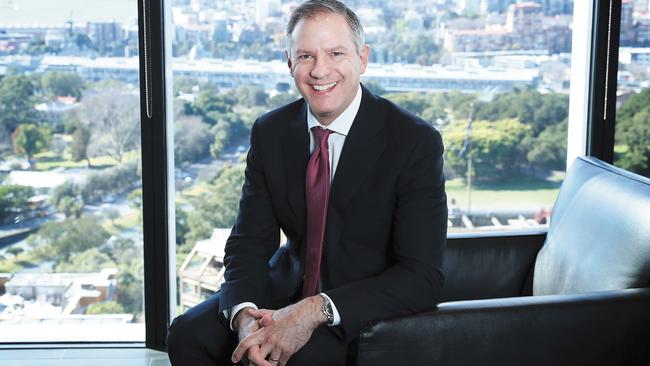Amcor has pushed through price hikes to its packaging customers to help bolster sales and earnings
The world’s largest packaging company has pushed through billions of dollars in price hikes to its customers to combat soaring inflation, which helped it grow sales and profit.

The boss of the world’s largest packaging company, Amcor, has taken on a more cautious view about the economic outlook due to softening demand from his key customers in December, although a silver lining to the gloomier settings was moderating inflation for raw materials used at its factories.
Amcor had successfully passed on $US670m ($964.8m) in price increases to its customers in the December half to counter soaring raw commodities prices for its packaging inputs and which followed another $US1.53bn in price hikes through 2022.
But now the cost of Amcor’s key raw materials, led by plastics, resin and aluminium, had begun to recede and this could help alleviate inflationary pressures running through the supply chain from the packaging factory to the supermarket shelf.
In terms of the wider economic environment, Amcor boss Ron Delia said he had become slightly more pessimistic towards the end of calendar 2022 as he encountered choppy demand for packaging made from his 220 manufacturing factories spread across 43 countries, with orders from food, coffee, confectionary, meat and some discretionary products beginning to weaken.
“We are more cautious relative to the demand outlook as compared to where we were three or four months ago and that really comes down to what we saw in the December quarter,” Mr Delia said on Wednesday after Amcor reported net sales rose 6 per cent to $US7.35bn for the six months to December, as net income surged 62 per cent to $US691m, thanks in part to its price hikes and the sale of its businesses in Russia.
“We had volatile demand pretty much cross the board and ended up with October and November being fairly mixed, volumes generally flat across our business in those two months, but things softened in December and in particular we saw some destocking in our value chain.
“So all of which leads us to be a bit more cautious on demand specifically, as compared to where we were three or four months ago.”
That impact on consumer demand was evident in Amcor’s interim results and the final quarter of 2022, with North America packaging volumes only growing in the low single digit range where volumes were lower in categories such as condiments, fresh meat, snacks and confectionary. It was a similar story in Europe where Amcor’s customers in home, personal care, coffee and confectionery also bought up less packaging products.
Mr Delia said this softening in demand was particularly evident in discretionary products but also some non-discretionary or “defensive” sectors that likely was driven by shoppers pulling back on purchases as prices at the store followed soaring inflation through 2022.
“I think what it tells us is that even in very defensive end markets, like the fast moving consumer good space, and like the healthcare space, there is a point at which cumulative inflation that the consumer has to wear starts to impact purchase decisions. And I think in some segments, we are starting to see that.”
Amcor, which is listed on the New York Stock Exchange as well as the ASX, saw its coffers filled in the December half with an extra $US365m from the sale of its Russian businesses. The factories were put up for sale soon after the invasion of Ukraine and have been sold to a local Russian investor, with some of the cash injection to be used to fund an additional $US100m share buyback that was announced on Wednesday.
The new buyback takes Amcor’s cash returns via that mode to shareholders to up to $US500m in fiscal 2023, and on Wednesday the company also unveiled a quarterly dividend of US12.25c a share, up from US12c in the prior corresponding quarter, that will be paid on March 21.
In 2022, Amcor announced it had pushed through price increases to its customers of more than $US1.5bn, equating to price hikes of around 12 per cent, as soaring inflation for key packaging raw commodities ate away at its margins and forced it to seek to reclaim some of that from its clients.
Amcor said it clawed back price increases of $670m in the first half. For the three months to December, net sales rose 4 per cen rise to $US3.64bn, of which included $US270m of price increases.

Mr Delia said the company delivered strong financial performance for the first half of fiscal 2023, demonstrating its excellent operating leverage amid ongoing challenges in the macroeconomic environment.
This included the successful recovery of higher costs from customers.
“We continue to make good progress on our commercial and strategic agenda and our teams are doing an excellent job navigating through volatile market conditions, while recovering general inflation and higher raw material costs.
“Our exposure to consumer staples and healthcare end markets positions our business well despite some softening in the demand environment and customer destocking through the December quarter.”
On the full year outlook, Amcor maintained its adjusted earnings per share and free cash flow ranges at US77-81c a share and $US1bn-$US1.1bn, respectively.
Amcor shares closed 3.3 per cent lower at $16.70 on the ASX.






To join the conversation, please log in. Don't have an account? Register
Join the conversation, you are commenting as Logout